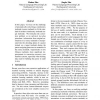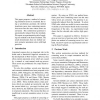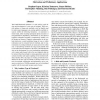COLING
2010
13 years 9 months ago
2010
In this paper, we focus on the challenge of automatically converting a constituency treebank (source treebank) to fit the standard of another constituency treebank (target treeban...
ACL
2009
14 years 7 days ago
2009
This paper proposes an approach to enhance dependency parsing in a language by using a translated treebank from another language. A simple statistical machine translation method, ...
EMNLP
2010
14 years 12 days ago
2010
Parser disambiguation with precision grammars generally takes place via statistical ranking of the parse yield of the grammar using a supervised parse selection model. In the stan...
ACL
2010
14 years 13 days ago
2010
This paper proposes a method of correcting annotation errors in a treebank. By using a synchronous grammar, the method transforms parse trees containing annotation errors into the...
LRE
2008
14 years 1 months ago
2008
In this paper we describe the current state of a new Japanese lexical resource: the Hinoki treebank. The treebank is built from dictionary definitions, examples and news text, and ...
COLING
2002
14 years 2 months ago
2002
The LinGO Redwoods initiative is a seed activity in the design and development of a new type of treebank. While several medium- to large-scale treebanks exist for English (and for...
IJDAR
2007
14 years 2 months ago
2007
This paper describes how a treebank of ungrammatical sentences can be created from a treebank of well-formed sentences. The treebank creation pro
LRE
2008
14 years 2 months ago
2008
Abstract. We introduce LTAG-spinal, a novel variant of traditional Lexicalized Tree Adjoining Grammar (LTAG) with desirable linguistic, computational and statistical properties. Un...
LRE
2008
14 years 2 months ago
2008
We have constructed a large scale and detailed database of lexical types in Japanese from a treebank that includes detailed linguistic information. The database helps treebank anno...
ACL
1994
14 years 3 months ago
1994
An automatic treebank conversion method is proposed in this paper to convert a treebank into another treebank. A new treebank associated with a different grammar can be generated ...



